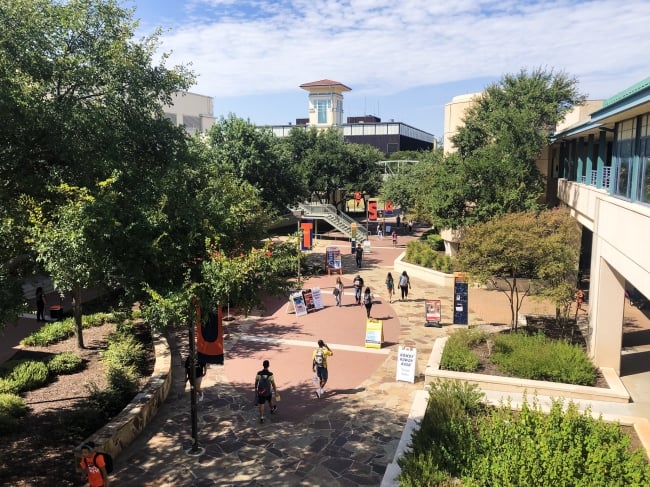You have /5 articles left.
Sign up for a free account or log in.

Students at the University of Texas at San Antonio can participate in a paid, experiential learning project through the Najim Center regardless of class standing or GPA.
University of Texas at San Antonio/Flickr
The University of Texas at San Antonio offers students the opportunity to put their classroom knowledge into practice, creating paid experiential learning opportunities with local businesses for all students across disciplines.
The Strategist program is an eight-week research opportunity for students to work alongside San Antonio industry leaders to identify and solve a problem for an organization, housed in the Harvey E. Najim Center for Innovation and Career Advancement. Program participants learn professional development skills, gain résumé experience and get paid for their contributions.
What’s different: While the model of pairing students with local organizations to provide business solutions is not a new model, UTSA’s work removes barriers to entry.
There is no GPA requirement, which allows students to “come as you are,” explains Erica Clark, associate director of innovation and career advancement at the Najim Center.
The Strategist program is not housed in an academic department or a course, so students don’t participate for academic credit, though UTSA business students complete a similar project for their capstone course.
The program unites students across majors, grade levels and degree programs to work on programs, diversifying the team’s knowledge, skill set and background.
“One of the projects, we had a science major, a history major, a mechanical engineering major and a finance major, and they were working on a social media strategy for a company,” Clark says.
Program participants are also paid $10 an hour across their eight weeks of work, culminating to around $800. Student pay comes from the center’s budget, but sometimes business partners provide some or all of their student team’s payment funds, as well.
How it works: Students apply to the program prior to the start of the semester, responding to a short essay question about why they’re interested in participating.
For most students, this is the only action needed, while others will complete an interview if Najim staff members feel they need to collect additional information to get to know the applicant.
Students are then connected in small groups and paired with a local business facing a problem they’re seeking student research and input on. Often, businesses are looking to improve their marketing or communication strategies, like embracing a brand identity or streamlining messaging to customers.
Most businesses get involved with the program from their own outreach, covering a wide range of industries in San Antonio, from UTSA’s history department to a real estate group and a historic movie theater.
UTSA provides a staff-to-student liaison, program coordinator Katherine Rico, and each partnering business selects a liaison to touch base with the student team weekly.
Every week, students complete short, written reflections responding to prompts, which provide program staff with an update on their work and insight into learning outcomes and personal development.
At the end of the eight weeks, students present their research and recommendations to the partnering businesses.
The impact: The program launched in fall 2021 with four students supporting a local business. In spring 2023, the program had 11 teams with over 40 students participating. For the upcoming fall semester, there’s a waiting list of students interested in participating that do not have a team assignment yet.
“We are getting a little bit competitive … but our hope is that we’ll be able to take all the students at some point through the program,” Clark says.
Over the Strategist program’s four-semester history and 100-plus participants, only two students didn’t complete the process, Clark says, which speaks to the accessibility of the initiative.
Students share in their reflections that they’ve improved their professional skills like critical thinking, problem solving, conflict resolution and leadership, Rico says. The program also developed connections between students’ academics and curricula to real-world applications.
So far, 100 percent of the organizations have implemented Strategist participants’ recommendations, as well, Clark says.
Looking ahead, Clark hopes the program will grow, involving more students and businesses each term, expanding experiential learning at UTSA.
If your student success program has a unique feature or twist, we’d like to know about it. Click here to submit.






.jpg?itok=QW-IeiPc)
